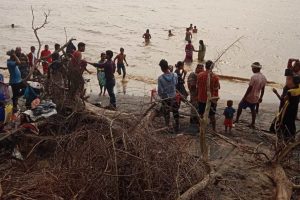Vanishing land: Kendrapara’s battle with coastal erosion

Kendrapara: Large swathes of Kendrapara district are under threat as coastal erosion, driven by rising sea levels and climate change, continues to eat away at the land, displacing communities, damaging forests, and endangering cultural heritage.
On June 25, during the new moon, seawater surged past the shoreline and entered Tand village under Mahakalapada block, raising concerns over accelerating coastal erosion. The situation has become dire along nearly 28 km of the 48 km-long Bay of Bengal coastline in Kendrapara district.
In Satabhaya, almost 40 metres of shoreline vanished within the past year alone. The iconic centuries-old Panchubarahi Temple in Rajnagar block has seen its surroundings transformed, with fears looming that the nearby Barahipur village may vanish during this monsoon. The advancing sea now threatens the coastal Sunei-Rupei forest.
To mitigate further loss, environmentalists and locals stress the urgent need to convert remaining farmlands in Satabhaya into protective casuarina (hental) forests.
Sudarshan Swain, a displaced resident of Barahipur now living in Bagapatia, explained that Satabhaya panchayat once comprised seven revenue villages, all of which have been lost to the sea over the past five decades. Only faint traces remain of villages like Magarakanda and Adhasala.
In the last 40 years, rising sea levels and tidal surges have displaced hundreds. Five years ago, after prolonged struggle, 571 families from the region were relocated to Bagapatia. With high tides intensifying, the Sunei-Rupei forest now faces destruction, and residents warn of future danger without long-term solutions.
Environmental expert Hemant Kumar Rout emphasised the failure of geo-synthetic tube walls installed at Pentha that are unable to withstand tidal force. Gabion boxes filled with stones are being dismantled by the sea, and even stone embankments are proving ineffective, he said.
He attributed the rising sea level to global warming and climate change, which intensify tidal waves during new moon and full moon phases. Rout underlined the need for expanding protective casuarina forests, although inadequate freshwater supply — less than 15% in dry seasons against the 40% requirement — hampers the growth of coastal wetlands.
Social worker Pramila Mallick recalled that the Agaranasi island, located 7 km offshore, once acted as a natural barrier against tidal forces. Since its complete submergence in 2022, coastal villages such as Tanda, Suniti and Babara have been exposed to frequent flooding during high tides and storms, endangering lives and livelihoods.
According to ACF Manas Kumar Das, afforestation efforts have been prioritised along the coast, with extensive plantation drives in Satabhaya and Pentha. Experts have been consulted, and reports on erosion are being compiled to formulate strategic interventions.
PNN
News